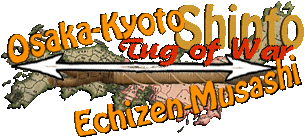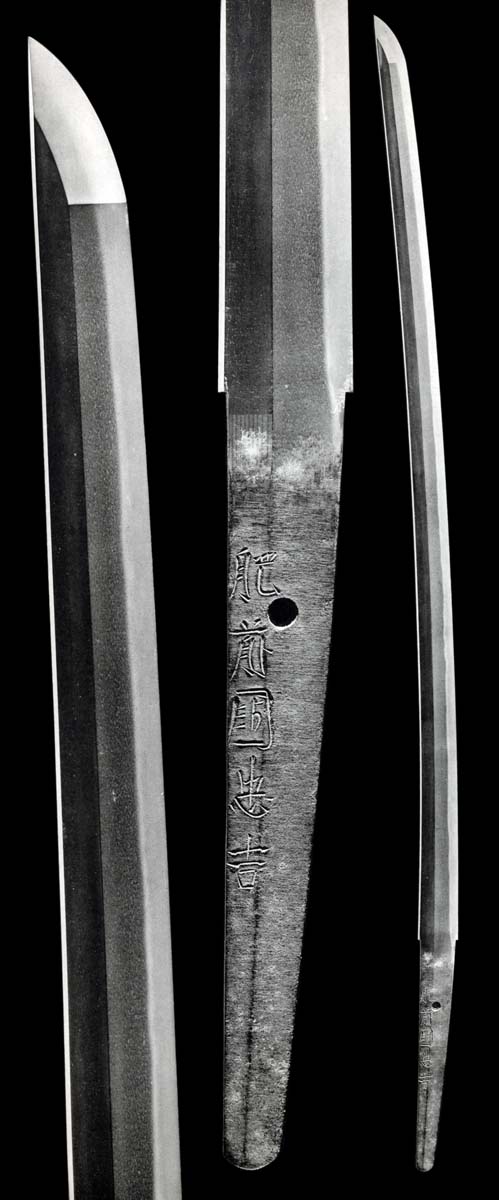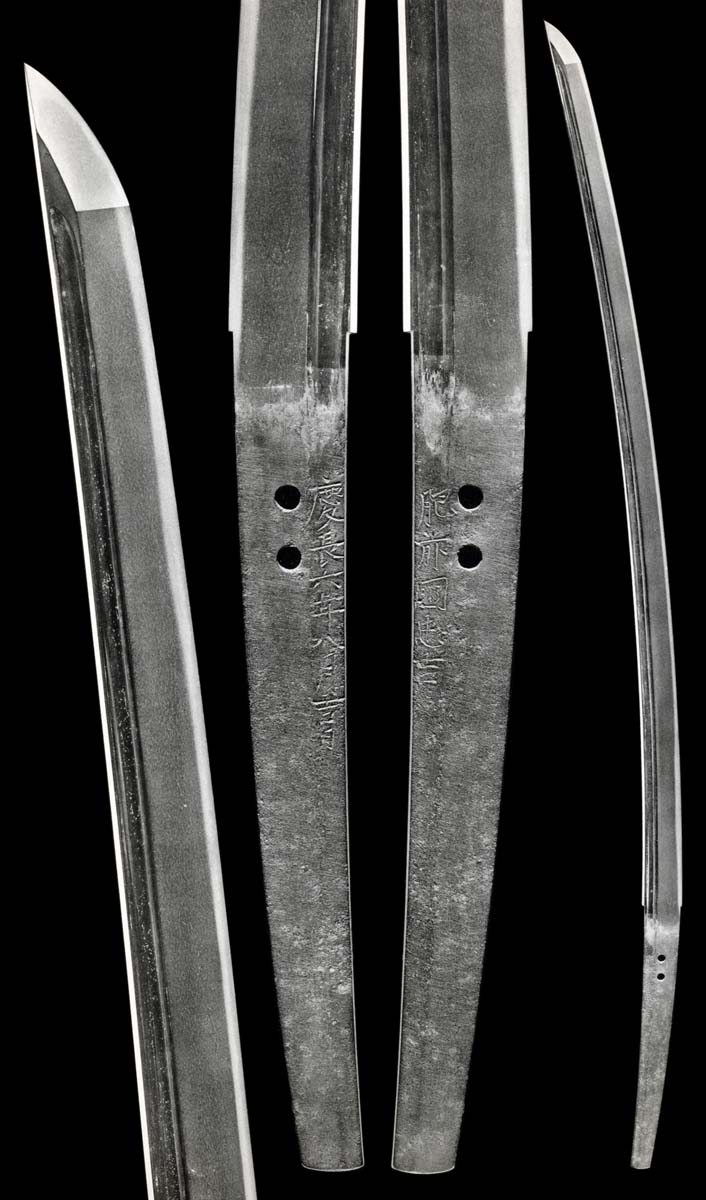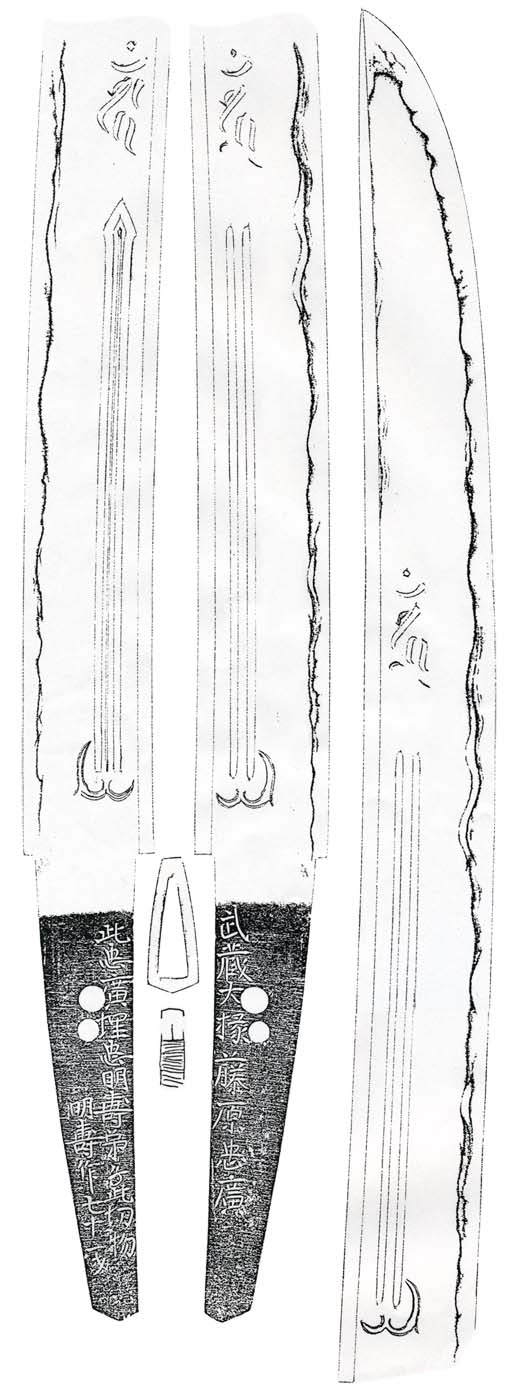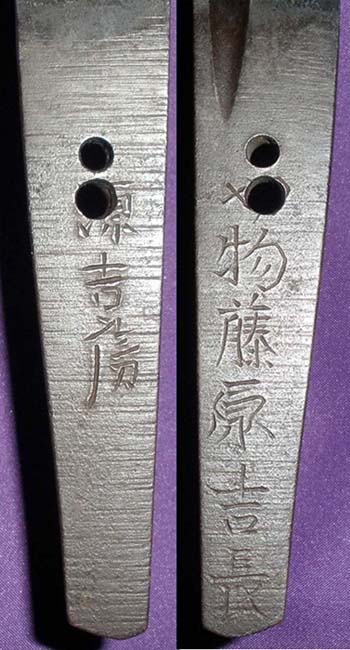HIZEN - SHINTO
APPRAISAL GROUP:
ECHIZEN - MUSASHI
One of the
five greatest SHINTO smiths
was HIZEN TADAYOSHI.
The HIZEN style stands
out and is easily
recognized. Elegant
SHINTO SUGATA, strong-grain
gray steel, CHU-SUGUHA in
NIE, and ŤHIZEN NAKAGO.
SUGATA - SHINTO SUGATA. Always well
shaped
with a certain refined strength
or
broadness to the blade.
HADA - Tight, pronounced KO-MOKUME
JI-HADA. Some
O-MOKUME in early pieces.
Medium-light
blue-gray to light gray-blackish
steel.
Thin skinned. Dark core-patches may
be seen.
There will be JI-NIE.
HAMON - HIRO or CHU-SUGUHA in
well-formed and fine
KO-NIE. There were NOTARE O-GUNOME,
O-MIDARE
GUNOME, and CHOJI-MIDARE patterns
but the
HIRO or CHU-SUGUHA is a school mark.
SUNAGASHI and ASHI. KINSUJI and
INAZUMA.
BOSHI - SUGU with MARU KAERI. An
even width of YAKIBA.
Often swords with an active HAMON
will have
the activity repeated in the BOSHI
with a
TOGARI and medium turnback. Some
HAKIKAKE.
NAKAGO - Long, with a graceful
appearance.
Like the blades, a certain fullness
to the planes. The shape is not
stark or imposing. JIRI is either
KENGYO or KURI with YASURI in the
main smith lines being a YOKO or
a particular KATEAGARI.
Both HAMON and JI-HADA will
be uniform and well-executed.
HIZEN Tree
- SHINTO and SHIN-SHINTO
TADAYOSHI - YAMASHIRO -
MUNENAGA
|
(1) KEI-CHO 1596
|_____________________________________________
|_________
_____ _____________ __________
_____ _________
__________
|
___|_______ |
____|_______
____|________
| ____|_______
|
___|_______
|
TADAHIRO |
TADAYOSHI MUNETSUGU
| YOSHISADA
|
TADAKIYO
|
___|________ |____
____________
___|_______
_____|_____
___|_______
|
TADAYOSHI
____|________
___|_______
HIROSADA
YOSHIFUSA
TADAKIYO |
___|________ YOSHINOBU
HIRONORI
|___________
___|________ |
TADAYOSHI
|____________
___|_______
___|_______
TADAMUNE
|
___|________
____|______
____|_______ TADAKUNI
KUNIHIRO
_________|
TADAYOSHI YUKIHIRO
MASAHIRO
___|_______
___|_______
____|________
___|________ ____|______
___|_______
TADAKUNI KANEHIRO
YOSHINAGA
TADAYOSHI
YUKIHIRO
MASAHIRO
____|______
|_____________
___|________
TADANAGA
___|________
____|_______ MASANAGA
TADAYOSHI (1)
TADAYOSHI
MASAHIRO
First made MIDARE.
Mid-period:
|______________
signed
"JU-NIN" and
refined
___|________
____|_______
the style
to SUGU or stronger
TADAYOSHI
YOSHIKANE
KO-MIDARE with ASHI and HOTSURE |
TADAYOSHI(1) KEICHO (f: NAGASE HASHIMOTO MICHIHIRO):
HASHIMOTO SHINZAEMON. SAGA JU NAGASE School.
Under NABESHIMA NAOSHIGE, DAIMYO of HIZEN.
Studied under UMETADA MYOJU from the beginning
of the KEICHO. He returned to HIZEN in 1598 to
work at the Castle in SAGA.
He received MUSASHI DAIJO in GENWA JUNEN, 1624.
TADAYOSHI died on KANEI KUNEN HACHI GATSU JUGO,
1632, 8TH month, 15th day, age, 61.
Beginning work will be standing HADA with HAMON
in AOI style, NAGAYOSHI style or SHIZU style
and can be mistaken for such old style works.
By KEICHO JUNIN 1605, we see the HIZENTO style
emerge with KO-NUKA rice-bran HADA AND KO-NIE
DEKI CHU-SUGUHA HAMON. Also, of course, NOTARE
and GUNOME-CHOJI MIDARE BA, all settled into a
HIZEN arch-type. He sought and attained a
perfection and grace in the conservative SUGUHA.
His HAMON may have a gentle or subtle
ASAKI-NOTARE undulation. HABUCHI can be
KUICHIGAI HATARAKI and NIJUBA.
His NOTARE may seem set in groups of four or
five. HAMON will show a strength or emphasis to
upper. Simple signatures will tend to be early.
TADAYOSHI
HI TADAYOSHI
HIZENnoKUNI TADAYOSHI
HIZENnoKUNI JU TADAYOSHI
HIZENnoKUNI JUNIN TADAYOSHI
HIZENnoKUNI JUNIN MINAMOTO TADAYOSHI
HISHU JU TADAYOSHI KORE UMETADA MYOJU DESHI
HIZENnoKUNI HASHIMOTO SHINZAEMONnoJO TADAYOSHI SAKU
HIZENnoKUNI SAGA JU HASHIMOTO SHINZAEMONnoJO TADAYOSHI SAKU
HIZENnoKUNI FUJIWARA TADAHIRO
MUSASHI DAIJO FUJIWARA TADAHIRO
HIZENnoKUNI JU MUSASHI DAIJO FUJIWARA TADAHIRO
See Tadayoshi
TADAHIRO(2) His father, TADAYOSHI(1) was 52 at the
birth of his son in 1613. SHODAI TADAYOSHI is
called the first TADAHIRO, taking that MEI when
his son was just 10, right at the beginning of
KAN-EI 1624. 9 years later, the son inherits
with the death of his father, HASHIMOTO
SHINZAEMON, then signing, “MUSASHI DAIJO
TADAHIRO”, who has been signing as both, 1st
TADAYOSHI and 1st TADAHIRO. His 19 year old
son, and therefore 2nd generation TADAYOSHI,
took the late signature, TADAHIRO and is known
as the 2nd generation of this HIZEN TADAYOSHI
line.
He is the 2nd TADAHIRO and has weathered the
flood of confusion from having been labeled
the 1st and 2nd true TADAHIRO and 2nd TADAYOSHI,
all true!
HIROSHIGE KAN-EI (t: TADAYOSHI): SABANOSUKE. Made
KO-NIE DEKI GUNOME CHOJI-MIDARE BA.
HIZEN-no-KUNI HIROSHIGE
HIZEN-no-KUNI JU HIROSHIGE
|

|
